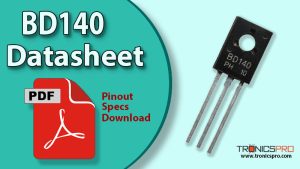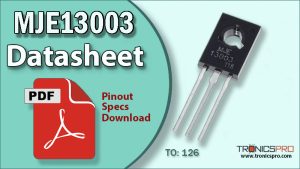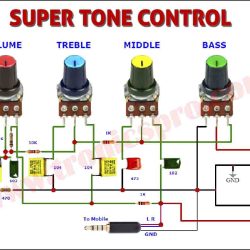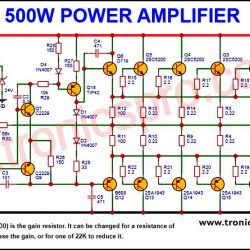The BD646 PNP transistor is a high-gain Darlington power transistor designed for audio amplifiers, power control, and high-current switching applications. It serves as the PNP complementary transistor to BD645, making it an essential component in push-pull amplifier stages and power driver circuits.
In this guide, we’ll explore the BD646 pinout, datasheet parameters, working principle, and key applications, along with alternatives and FAQs for practical circuit use.
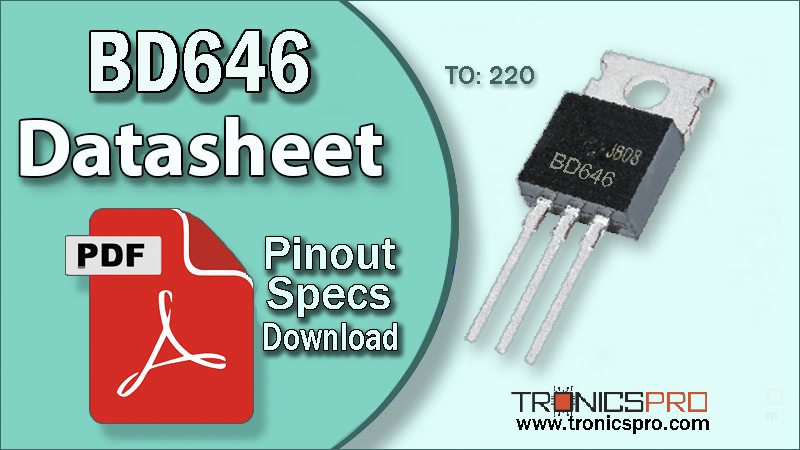
Introduction to BD646 PNP Transistor
The BD646 is a PNP Darlington transistor housed in a TO-220 package, engineered for high-current and high-gain amplification. It internally contains two PNP transistors connected in a Darlington configuration, multiplying the current gain while maintaining excellent linearity for audio and switching circuits.
Due to its high current capacity (up to 8 A) and voltage handling up to 60 V, the BD646 is widely used in power output stages, inverters, and control modules.
Its complementary NPN transistor, BD645, is used in the same circuit to amplify the opposite signal phase, forming a balanced and efficient push-pull configuration.
BD646 PNP Transistor
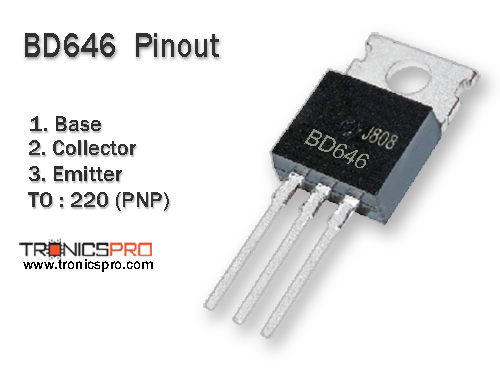
Pinout of BD646

Understanding the BD646 Pinout Configuration
The BD646 transistor pin configuration is straightforward and identical in layout to most TO-220 power transistors. The pins are arranged as Base, Collector, Emitter (B-C-E) when viewed from the front (with the metal tab or heat sink at the back).
Pin Configuration of BD646 Pinout
| Pin# | Pin Name | Pin Description |
|---|---|---|
| 1 | Base | Controls transistor operation and current flow |
| 2 | Collector | Main output terminal (connected to the load or supply) |
| 3 | Emitter | Output terminal connected to ground or negative rail |
The metal tab on the transistor is internally linked to the collector, so proper insulation is recommended if multiple devices are mounted on a shared heat sink.
Key Features of BD646 Transistor
- High current gain with Darlington pair configuration
- Complementary device to BD645 (NPN)
- High collector current capability (up to 8 A)
- Low saturation voltage and excellent thermal stability
- TO-220 package for efficient heat dissipation
- Ideal for audio amplifiers, regulators, and motor control circuits
BD646 Transistor Datasheet and Specifications
Below are key electrical and thermal characteristics of the BD646 transistor, extracted from its datasheet for accurate circuit design:
- Collector-Emitter Voltage (Vceo) = –60 V
- Collector-Base Voltage (Vcbo) = –80 V
- Emitter-Base Voltage (Vebo) = –5 V
- Continuous Collector Current (Ic) = –8 A
- Peak Collector Current (Icm) = –12 A
- Power Dissipation (Pc) = 62.5 W at Tc = 25 °C
- DC Current Gain (hFE) = 750 (minimum at Ic = –3 A)
- Collector-Emitter Saturation Voltage (Vce(sat)) = –2.0 V max
- Base-Emitter Voltage (Vbe(on)) = –2.5 V max
- Thermal Resistance Junction to Case = 2 °C/W
- Operating Junction Temperature = –65 °C to +150 °C
These ratings make BD646 suitable for heavy-duty applications where high current gain and power dissipation are critical.
Working Principle of BD646 PNP Transistor
The BD646 PNP Darlington transistor operates by amplifying current through two internal transistors connected in cascade. A small current applied to the base allows a much larger current to flow from the emitter to the collector.
When used in amplifier circuits, it conducts during the negative half-cycle of an AC waveform, while its complementary BD645 NPN conducts the positive half. Together, they form class-B or class-AB amplifier stages with excellent efficiency and linearity.
In switching applications, BD646 operates as a high-current switch, turning fully ON when the base is driven low relative to the emitter.
More Circuit Layouts

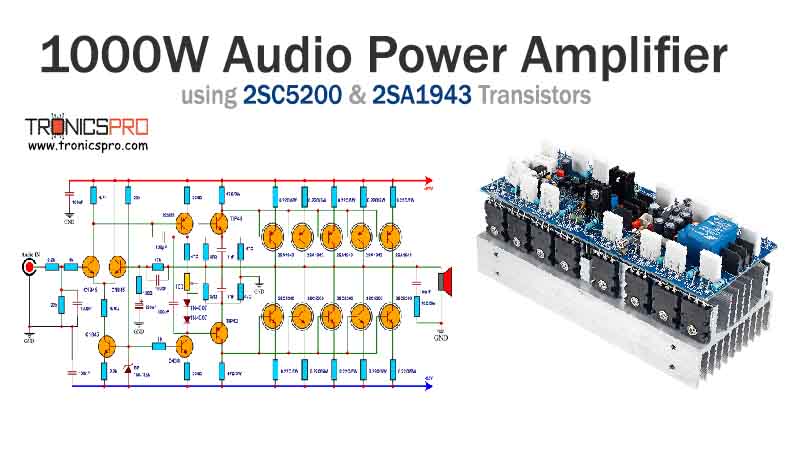
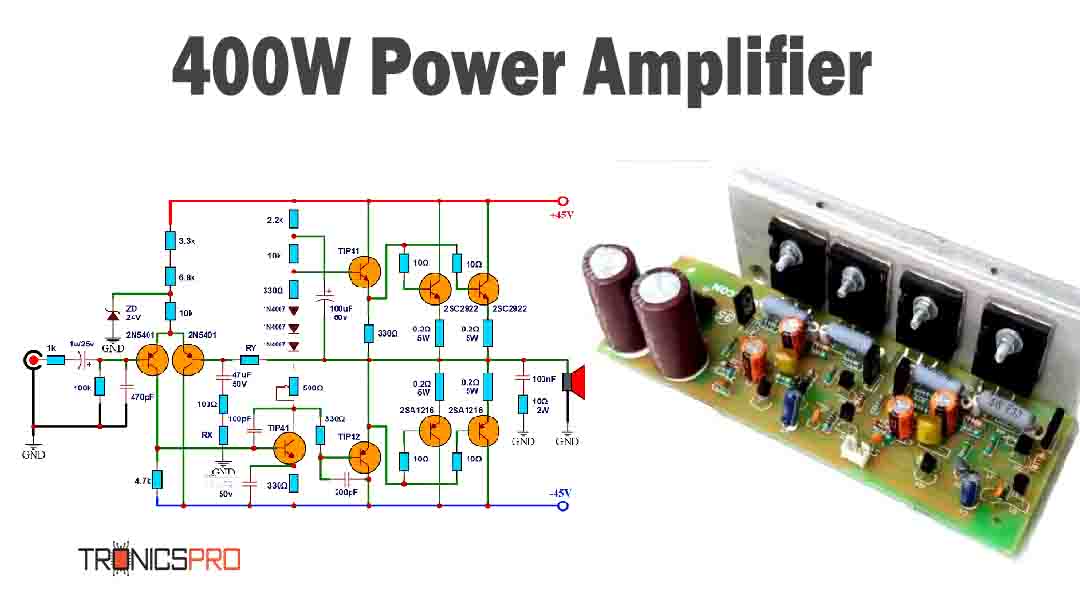
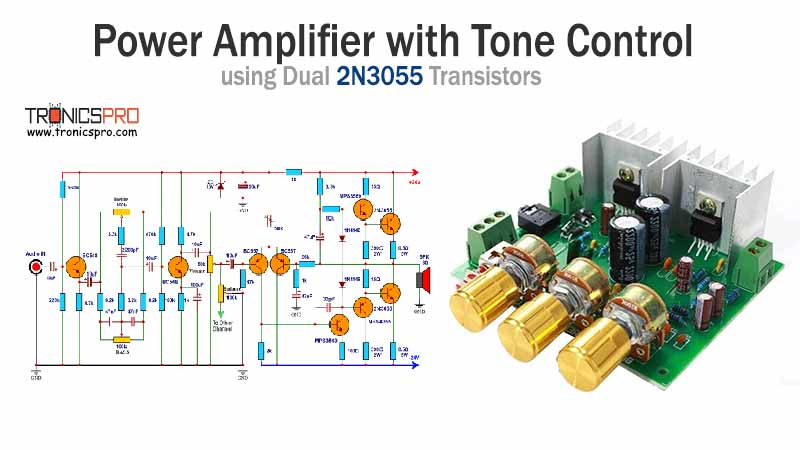



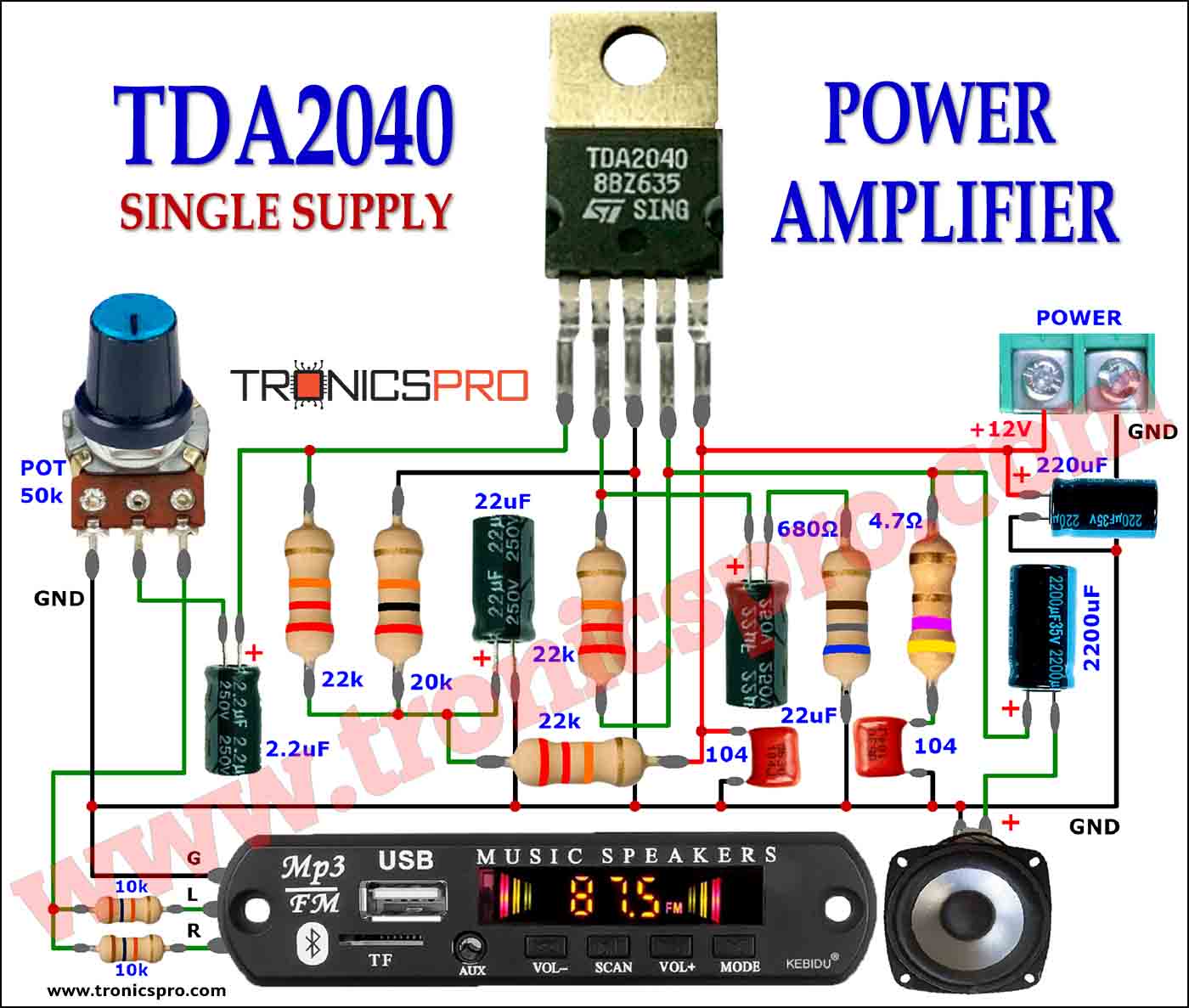
Typical Applications of BD646
- Audio amplifier output and driver stages
- Voltage and current regulator circuits
- Relay and solenoid drivers
- Power control and switching systems
- Inverters and UPS circuits
- Motor speed control modules
NPN Complementary Transistor
The BD645 is the complementary NPN transistor to BD646.
When paired, they form an NPN–PNP Darlington pair ideal for push-pull amplifier designs or symmetric power switching circuits.
Using these transistors together ensures balanced current amplification and efficient heat distribution, reducing distortion in audio and power applications.
Equivalent Transistors and Alternatives
If the BD646 transistor is unavailable, several equivalent PNP Darlington transistors can be used, depending on voltage and current requirements:
- BD648 (higher voltage version)
- BD650 (higher current capability)
- TIP125 / TIP127 (similar Darlington type, lower current)
- MJ11016 or MJD127 (power Darlington PNP equivalents)
Always ensure that the substitute matches the collector current (Ic) and voltage (Vce) requirements of your circuit.
Comparison BD646 vs BD645 Complementary Transistors
The BD646 (PNP) and BD645 (NPN) transistors are complementary Darlington devices designed for dual-phase amplification.
While the BD645 conducts during the positive half of the signal (NPN conduction), the BD646 conducts during the negative half (PNP conduction).
Both share identical electrical ratings, ensuring symmetrical operation in audio output stages, regulator circuits, and power amplifiers.
| Parameter | BD645 (NPN) | BD646 (PNP) |
|---|---|---|
| Polarity | NPN | PNP |
| Complementary | BD646 | BD645 |
| Collector Current (Ic) | 8 A | -8 A |
| Collector-Emitter Voltage (Vceo) | 60 V | -60 V |
| Package | TO-220 | TO-220 |
| Gain (hFE) | 750 | 750 |
Frequently Asked Questions (FAQ)
What is the BD646 transistor used for?
The BD646 PNP transistor is used in audio amplifiers, motor drivers, voltage regulators, and other power switching circuits.
What type of transistor is BD646?
It is a PNP Darlington power transistor, combining two PNP transistors internally for high gain.
What is the BD646 pin configuration?
Pin 1 = Base, Pin 2 = Collector, Pin 3 = Emitter.
The metal tab is also connected to the collector. Complete detail of BD646 Pinout is provided above. Download button is also provided below for BD646 Datasheet.
Is BD646 complementary to BD645?
Yes. BD645 (NPN) and BD646 (PNP) are complementary Darlington transistors designed to work together in amplifier circuits.
What is the maximum current of BD646?
The transistor can handle up to 8 A continuous and 12 A peak current, depending on heat dissipation conditions.
Can I replace BD646 with TIP127?
Yes, in many low to medium power circuits, TIP127 can be used as a replacement, but verify current and voltage limits first.
Conclusion
The BD646 PNP transistor is a robust and reliable Darlington power transistor that excels in high-gain amplification and current control applications. When paired with its complementary BD645 NPN transistor, it delivers exceptional performance in audio, inverter, and motor driver circuits.
With its strong current gain, durable TO-220 design, and compatibility with several equivalents, the BD646 transistor remains a preferred choice for both beginners and professional circuit designers.
Datasheet of BD646 NPN Transistor
Click the following Button to download the datasheet of BD646 Transistor :
More projects, You may like:
- Video Transmitter DIY Homemade FM Radio Transmitter
- Adjustable Power Supply DIY Battery Charger
- 12V-220V 500 Watt inverter DIY Homemade
- MPPT Solar Charge Controller DIY Homemade
- DIY LA4440 bass amplifier homemade
For more project and circuit diagrams, you can go through the Schematics in the main menu where you can find many interesting projects and circuit diagrams like audio amplifier circuits, voltage booster circuit, battery charger circuit and timer circuits etc., which are all beginner circuit projects. Feel free to check them out!

Thank you for visiting the article.






